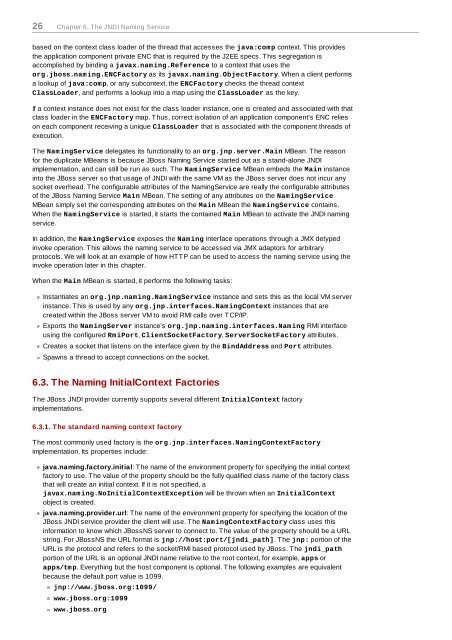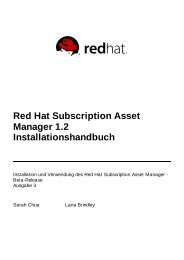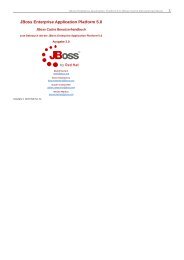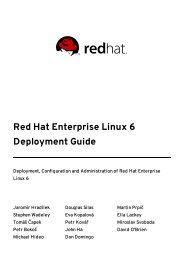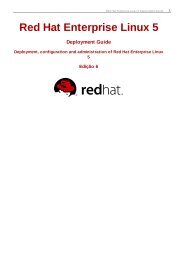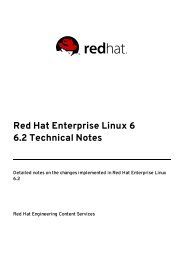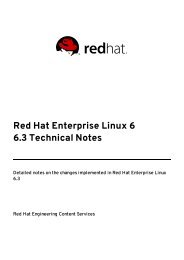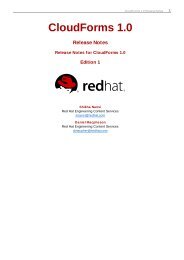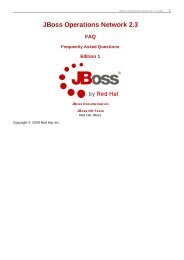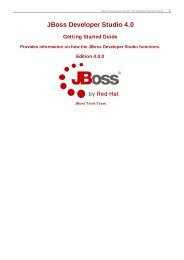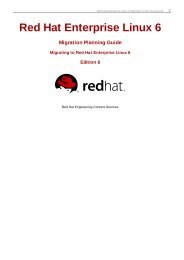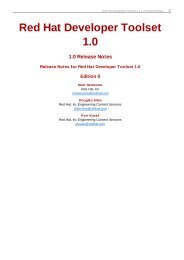JBoss Enterprise Application Platform Common Criteria Certification ...
JBoss Enterprise Application Platform Common Criteria Certification ...
JBoss Enterprise Application Platform Common Criteria Certification ...
You also want an ePaper? Increase the reach of your titles
YUMPU automatically turns print PDFs into web optimized ePapers that Google loves.
26 Chapter 6. The JNDI Naming Service<br />
based on the context class loader of the thread that accesses the java:comp context. This provides<br />
the application component private ENC that is required by the J2EE specs. This segregation is<br />
accomplished by binding a javax.naming.Reference to a context that uses the<br />
org.jboss.naming.ENCFactory as its javax.naming.ObjectFactory. When a client performs<br />
a lookup of java:comp, or any subcontext, the ENCFactory checks the thread context<br />
ClassLoader, and performs a lookup into a map using the ClassLoader as the key.<br />
If a context instance does not exist for the class loader instance, one is created and associated with that<br />
class loader in the ENCFactory map. Thus, correct isolation of an application component's ENC relies<br />
on each component receiving a unique ClassLoader that is associated with the component threads of<br />
execution.<br />
The NamingService delegates its functionality to an org.jnp.server.Main MBean. The reason<br />
for the duplicate MBeans is because <strong>JBoss</strong> Naming Service started out as a stand-alone JNDI<br />
implementation, and can still be run as such. The NamingService MBean embeds the Main instance<br />
into the <strong>JBoss</strong> server so that usage of JNDI with the same VM as the <strong>JBoss</strong> server does not incur any<br />
socket overhead. The configurable attributes of the NamingService are really the configurable attributes<br />
of the <strong>JBoss</strong> Naming Service Main MBean. The setting of any attributes on the NamingService<br />
MBean simply set the corresponding attributes on the Main MBean the NamingService contains.<br />
When the NamingService is started, it starts the contained Main MBean to activate the JNDI naming<br />
service.<br />
In addition, the NamingService exposes the Naming interface operations through a JMX detyped<br />
invoke operation. This allows the naming service to be accessed via JMX adaptors for arbitrary<br />
protocols. We will look at an example of how HTTP can be used to access the naming service using the<br />
invoke operation later in this chapter.<br />
When the Main MBean is started, it performs the following tasks:<br />
Instantiates an org.jnp.naming.NamingService instance and sets this as the local VM server<br />
instance. This is used by any org.jnp.interfaces.NamingContext instances that are<br />
created within the <strong>JBoss</strong> server VM to avoid RMI calls over TCP/IP.<br />
Exports the NamingServer instance's org.jnp.naming.interfaces.Naming RMI interface<br />
using the configured RmiPort, ClientSocketFactory, ServerSocketFactory attributes.<br />
Creates a socket that listens on the interface given by the BindAddress and Port attributes.<br />
Spawns a thread to accept connections on the socket.<br />
6.3. The Naming InitialContext Factories<br />
The <strong>JBoss</strong> JNDI provider currently supports several different InitialContext factory<br />
implementations.<br />
6.3.1. The standard naming context factory<br />
The most commonly used factory is the org.jnp.interfaces.NamingContextFactory<br />
implementation. Its properties include:<br />
java.naming.factory.initial: The name of the environment property for specifying the initial context<br />
factory to use. The value of the property should be the fully qualified class name of the factory class<br />
that will create an initial context. If it is not specified, a<br />
javax.naming.NoInitialContextException will be thrown when an InitialContext<br />
object is created.<br />
java.naming.provider.url: The name of the environment property for specifying the location of the<br />
<strong>JBoss</strong> JNDI service provider the client will use. The NamingContextFactory class uses this<br />
information to know which <strong>JBoss</strong>NS server to connect to. The value of the property should be a URL<br />
string. For <strong>JBoss</strong>NS the URL format is jnp://host:port/[jndi_path]. The jnp: portion of the<br />
URL is the protocol and refers to the socket/RMI based protocol used by <strong>JBoss</strong>. The jndi_path<br />
portion of the URL is an optional JNDI name relative to the root context, for example, apps or<br />
apps/tmp. Everything but the host component is optional. The following examples are equivalent<br />
because the default port value is 1099.<br />
jnp://www.jboss.org:1099/<br />
www.jboss.org:1099<br />
www.jboss.org


